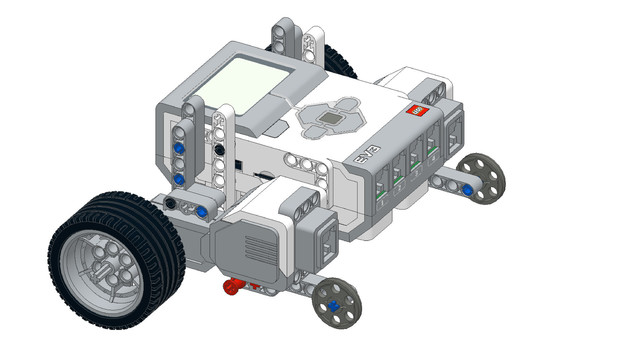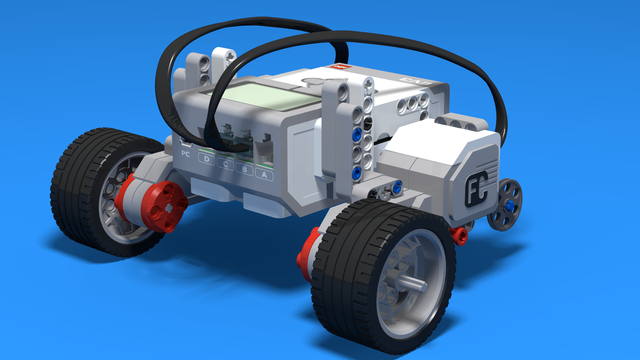Как се работи с тази задача за разпускане.
- #428
- 20 Apr 2017
- 3:02
Задайте граници
Не позволявайте на учениците да строят прекалено дълго и с твърде много части.
Определете време за строенето. 20 минути са добър компромис между време за творчество и време за постигане на бърз резултат.
Ако не зададете и не следите времето, учениците ще се заиграят и ще се отнесат.
Целта е просто да има нещо, което държи смартфона върху робота.
За шпионирането
Тук имате възможност да обсъдите моралните проблеми от шпионирането на другите. Шпионирането и подслушването си имат своите предимства и недостатъци.
Свобода да се експериментира
След като имате конструкция, можете да експериментирате с програмирането на воля, според даденостите на вашата класна стая.
Използвайте всичкия взет до сега материал и използвайте завои, движения напред назад, различните видове завои, за да достигнете "другата стая".
English
A note for the teacher when building the Camera on wheels Robot. This Camera on wheel task is a fun relief task. And when you try to do it it has two parts. First, building some kind of a construction that can hold the phone and then programming. When building with a group of students always set a limit to the time. Don't let them build for too much. You can let them build for 10, for 15, for 20 minutes but building for an hour for a simple construction that can hold the phone is way too much. So, set a limit and try to keep this limit. Try to make it transparent to the students that there is a limit and if they are not ready, they cannot continue and they should try to be ready at 20 minutes or 30. There are different students at different ages so you should consider this depending on your group set the time for constructing. Next, we call it a Spy Bot, a Spy Robot, a Camera on wheels and you can use this as an opportunity to discuss with students spying in general. There are different moral implications when spying and beforehand it is a good idea to discuss this with the students. Of course, if you are doing this at home, it's much easier but if you are doing it in a class and you program actually a robot that moves to another room with a camera and you take pictures with this camera, there are moral implications. For programming, when you finally place the camera on the robot modify the task depending on your classroom on your room that you are doing the classes. And you can always extend this program and modify it a little where exactly you go, what kind of turns you make. The goal is to move forward, backward and to do different kinds of turns. But the specific sequence is something that you can leave to the students. Just set the task as a whole. Move from here to here, take some pictures and return. And leave the details to them. And they'll come up with different solutions which is not bad and these different solutions will have advantages and disadvantages but you can leave them to come up with different solutions. No need to specify each of the blocks just the broad idea - from here to here and this path must involve different types of turns so that they could experiment with them and they could try them. But leave them as a broad idea. And the details will be filled by the students.
Курсове и занятия включващи този Урок
Този Урок е използван в следните курсове и занятия.

EV3 Phi. Introduction to robotics with LEGO Mindstorms
The things that you will be able to do with your EV3 robot by the end of this course are:
Freely move your robot towards desired target;
Avoid obstacles on the path of your robot using sensors;
Follow lines of any shape;
Detecting and picking up objects of any kind;
- 92
- 220:20
- 36

"Camera" on wheels
Време да приложим всичко научено досега на практика. Да направим робот шпионин!
- 2
- 0
- 2
- 3d_rotation 0

Ниво A - Въведение - Роботика с LEGO
Първото ниво от учебната програма по LEGO роботика за ученици от втори, трети и четвърти клас.
Едно, “пътешествие из космоса”, но с роботи. В нивото се изграждат различни конструкции на роботи. Управляват се моторите така, че роботите да извършват прецизни движения около „земята“, „луната“ и „слънцето”. Преодоляваме различни препятствия след като се блъснем в тях благодарение на сензора за допир. Изграждаме и програмираме роботи, които могат да се сражават и защитават стига това да се наложи.
- 142
- 133:42
- 187

Занятие 4 - Завой около Луната
Въведение
Днес роботът ни ще бъде космически кораб като предният. Целта ни днес, обаче, е конкретна: Да достигнем до далечната страна на Луната!
Къде се намира далечната страна на Луната? Защо е толкова трудна цел?
- 13
- 4
- 5
- 3d_rotation 1